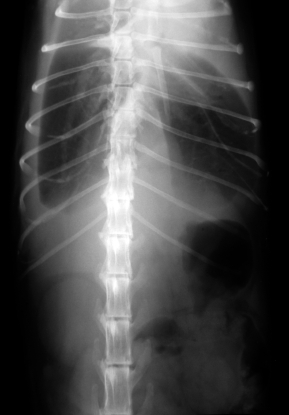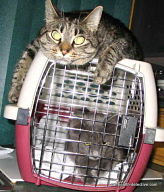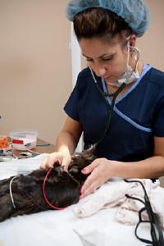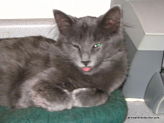Housecat Endoscopy

Housecat endoscopy...after a housecat has had numerous bouts of diarrhea and vomiting over a period of just a few months it is typical to take your little feline to the vet. After a thorough examination if your vet doesn't find anything obviously wrong, it is common to suggest that taking a tissue sample from your cat's stomach and intestines may help illuminate the cause of the problem.
While you may think that exploratory surgery is involved, nowadays, a clinician experienced in housecat endoscopy can peer inside your cat and take tissue samples without an invasive surgical procedure.
The clinician inserts an endoscope (a light-transmitting tube with a lens on the end) through your cat's mouth and into its stomach to view the organ's interior and remove and examine snippets of tissue (biopsy). Housecat endoscopy is used to diagnose many internal ailments ...even respiratory problems. Consider this internal surveillance.
Housecat endoscopy uses a scope to peek into the housecat stomach that has a long, flexible tube with a lens in the tip. The vet uses a control knob in the hand-piece of the endoscope to maneuver the lensed tip to view a wide area. The tube section consists of multiple channels. One or two channels contain fiber bundles that transmit light and one channel contains the lens that sends images back to the vet.
A separate channel is used to withdraw stomach fluid or to pass instruments such as biopsy forceps or cytology brushes (for taking biopsy samples) or grasping forceps (to remove foreign objects) to the end of the scope. Another channel is used to carry air to expand the stomach for easier viewing or to carry water for washing away mucus or other material obscuring the view.
Housecat endoscopy requires putting the feline patient under general anesthesia. Once the housecat is well into "dreamland," the technician introduces the scope through an appropriate natural opening such as the mouth or anus. If the signs of your cat's illness point to gastrointestinal (GI) distress he may insert the tube through your cat's mouth and into its stomach. Once he has maneuvered the scope into the organ under surveillance, he can begin to survey inside the cat.
By noting the texture and color of organ tissues, the vet obtains clues that will help diagnose the problem. Also, by using accessory attachments, the vet can take tissue samples for later laboratory analysis or even remove a foreign object ....such as a needle...from inside your cat.
While housecat endoscopy has become more common, don't be surprised if your vet doesn't do the procedure. The instruments not only are expensive, they require a significant amount of practice to become adept in their use.
So, many vets either refer patients to a hospital staffed with an endoscopist or enlist the services of a mobile endoscopist who comes to the veterinary clinic with the equipment and performs the procedure.
Veterinarians have become skilled at scoping several regions of your cat's body. Vets have discovered they get the best views of the stomach with the feline patient lying on its left side. In bronchoscopy the vet takes a view of the airways, while rhinoscopy involves peeking into the nose, and cystoscopy into the bladder. Vets can also examine a cat's esophagus and colon endoscopically.
The most common is to check the GI tract if a house cat shows signs of GI distress such as vomiting and diarrhea, weight loss, and appetite loss. The vet will begin to gather information by performing a physical examination and taking blood, urine, and stool samples for lab analysis. But if the results don't conclusively point to one disorder, the vet may take x-rays and possibly an ultrasound of the cat's abdomen, looking for structural abnormalities.
But sometimes, even these images don't provide enough information to form a clear picture of what's ailing the feline patient. An example ....inflammatory bowel disease(IBD), one of the most common causes of chronic vomiting and diarrhea in a housecat ...can only be diagnosed by analyzing tissue samples taken from the stomach and small intestine.
Most of the time, they go into the stomach and small intestine with doing the housecat endoscopy to get biopsy samples, usually suspecting something like IBD. Typically, 7-10 samples are taken from various sites.
The vet uses biopsy forceps to grasp a very small snippet ...only about 2-3 millimeters in diameter...of tissue from the stomach lining (biopsy sample). If the biopsy sample is taken surgically, it includes all the layers of the stomach tissue (full thickness biopsy). The biopsy results and the vet's visual assessment of the organ, combined with previous test results, usually enable the vet to make a diagnosis and begin appropriate treatment.
There are a few rare instances when an endoscopic analysis doesn't provide enough information for the vet to make a diagnosis. For example, diseased tissue can be buried deep in an organ wall and won't come to light through an endoscopic tissue sample, which removes only surface tissue.
In such cases, the vet will likely recommend surgery so he or she can take tissue samples that include all tissue layers of the organ. There are other times when the vet may diagnose your cat's illness with housecat endoscopy but will need to treat the problem surgically.
A housecat poses special endoscopic challenges because of their small size. Some cats are particularly small and you can't pass the scope into the upper reaches of their small intestines. However, housecat endoscopy has saved many fortunate feline patients from the stress of undergoing a surgical procedure. Plus, the technique has enabled vets to reach an accurate diagnosis quickly so the ill housecat can start down the recovery path.
Related Articles......
Return from Housecat Endoscopy to Cat Health Homepage
Having trouble finding what you need? Cat Health Index & Site Map
OR
Do you have a question to ask?...Questions
OR
Do you have a cat story to share?...Simply click here to go to that page!
Copyright@2010-2020 All rights reserved.Cat-health-detective.com
This website is information only. Consult a veterinarian for medical assistance

"Like Us" on Facebook
or...
"Like Us" here




















